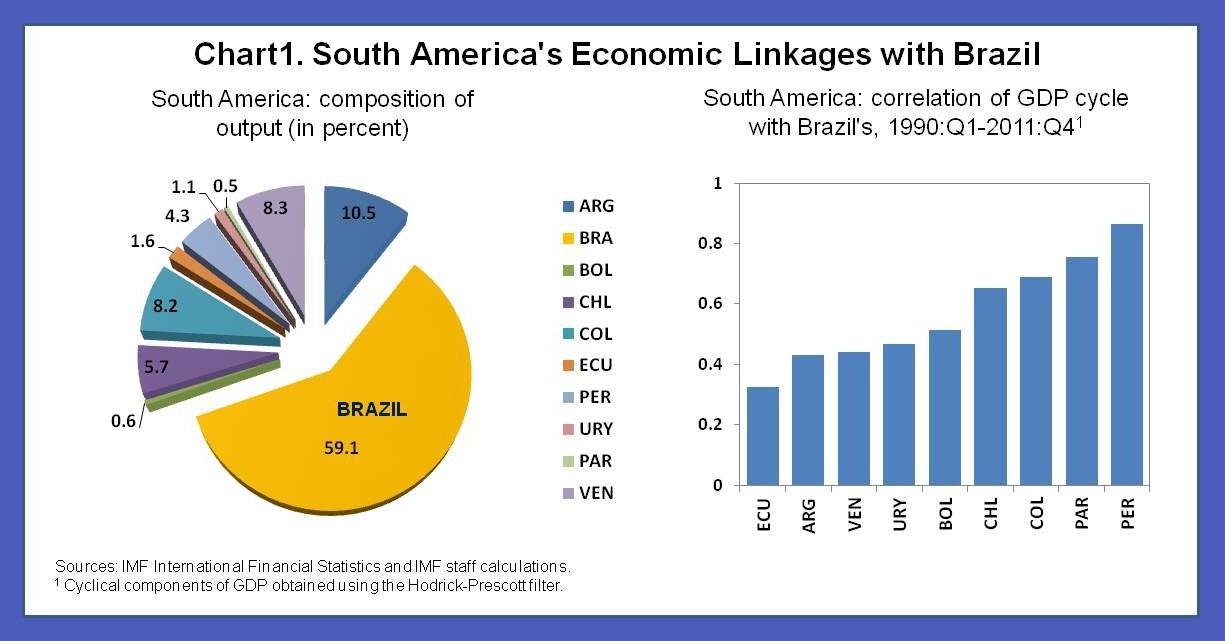The risks that policies and shocks in major economies can spillover on other countries and regions have become a matter of renewed concern since the global crisis of 2008–09. Brazil is South America’s giant; how important is its influence on neighboring countries?
Brazil accounts for 60 percent of South America’s output and its economic fluctuations are closely correlated with those of many of its neighboring countries. This would appear to suggest that economic activity in Brazil’s neighbors is strongly influenced by Brazil’s business cycle.
But these close comovements could also reflect common global factors that affect all South American countries similarly, such as commodity prices, international financial conditions, and global demand.
Our latest Regional Economic Outlook: Western Hemisphere examines this question, quantifying the importance of spillovers from Brazil to the rest of South America.
What are the linkages?
Trade linkages are the likely channel of transmission between Brazil and its neighbors. Direct financial ties, the other common channel, are almost negligible.
Although intraregional trade in South America increased markedly in the past decade, trade with Brazil contributed only marginally to this process. Brazil’s share in total exports of its neighbors dropped in the early 2000s and reverted to the levels of the early 1990s.
The story, however, varies significantly across countries.
Southern Cone economies (Argentina, Uruguay, Paraguay, Bolivia and—to a lesser extent—Chile) have relatively high export exposures to Brazil (measured both as percent of total exports and as a percent of GDP). Andean countries (Ecuador, Colombia, Peru, and Venezuela), on the other hand, have very limited trade linkages with the region’s giant—less than 3 percent of total exports or ½ percent of GDP.
This evidence suggests that the high comovements in economic activity between Brazil and most South American countries, are indicative of an exposure to spillovers from Brazil only in the case of the Southern Cone countries.
Neighborly spillovers
We use a statistical approach—covering the period 1990–2011—that allows us to strip the effects of common external factors to quantify spillovers from the large neighbor.
The results confirm that Brazil has a significant influence on Southern Cone countries, particularly on Mercosur partners (Argentina, Paraguay, and Uruguay), but not on the Andean economies.
For the Southern Cone countries, spillovers from Brazil can take two forms: the transmission of shocks originating in Brazil and the amplification (through Brazil) of global shocks.
These two factors explain an important share of the fluctuations in economy activity in the Southern Cone countries.
Impact of Brazilian real depreciation
We also assess the impact of Brazil’s currency depreciation on the business cycle of the South American economies.
Interestingly, our analysis finds no evidence of a significant impact of such a shock, even on Southern Cone countries.
We interpret these results as suggesting that the dampening effect on output of neighboring countries resulting from the appreciation of their bilateral real exchange rate vis-à-vis Brazil is largely offset by the expansionary effect of the depreciation on Brazil’s output and domestic demand.





